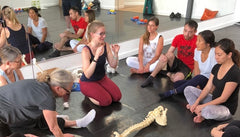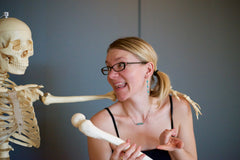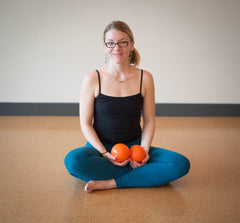Letter to Yogis: Understanding movement in a new way (Part 2)
By Alison Wesley, Franklin Method
JANUARY 2020
Dear Yogis,
Following the injury I sustained after years of overdoing what my yoga teachers instructed me, I found it revolutionary to learn to apply thinking in images to my yoga practice. When I first learned about the Franklin Method and its use of imagery, I began to understand movement in new ways.
 As an instructor, I use imagery in my practice using cues and I want to encourage you to do the same. We can teach people that movement, whether it is yoga (my favorite!), dance, or other physical activity, is something the body loves to do and is prepared to do. With the imagery of functional movement, we don’t need to tuck anything or lift anything or pull or push or isometrically drag anything. In fact, most of that just creates tension, which Eric Franklin so eloquently defines as the enemy of movement. Plus, when we cue the body over and over, we may create the belief that something is wrong. For example, “tuck your tail” can be interpreted that you were wrong by not tucking it. In such instances, it can be easy to walk away from a session thinking, “I don’t know how to move my body because the teacher knows more than me.”
As an instructor, I use imagery in my practice using cues and I want to encourage you to do the same. We can teach people that movement, whether it is yoga (my favorite!), dance, or other physical activity, is something the body loves to do and is prepared to do. With the imagery of functional movement, we don’t need to tuck anything or lift anything or pull or push or isometrically drag anything. In fact, most of that just creates tension, which Eric Franklin so eloquently defines as the enemy of movement. Plus, when we cue the body over and over, we may create the belief that something is wrong. For example, “tuck your tail” can be interpreted that you were wrong by not tucking it. In such instances, it can be easy to walk away from a session thinking, “I don’t know how to move my body because the teacher knows more than me.”
This deep misconception can keep one from practicing the very important yogic principle of self-study and learning oneself. It can lead to thinking that our bodies need to be tamed or fixed. We can also start defining ourselves and our movements in terms of our limitations, our asymmetries, our injuries, or in my case, diseased discs that will never heal.
This became even more clear to me at a workshop I once taught when I asked a group of yoga teachers what the purpose was behind understanding our own bio-mechanics. One woman quickly replied, “To prevent injury.” Another said, “To learn our imbalances.” And another said, “To avoid pain.” As much as understanding our bio-mechanics can help with each of those, think of what these answers reveal. They reflect a distrust of the design of our own bodies, not to mention a belief that the body is inherently fragile.
In the field of teaching movement, if students hear they are to engage or to support something in order to protect something else, they learn that their bodies need to be protected from movement. Something as simple as “Lift your navel to protect your lower back,” can add a tiny undercurrent of fear.
As a teacher, I meet so many yogis who tell me they have an unstable sacroiliac joint (S/I), the place where the sacrum meets the pelvic halves, and assure me, “Don’t worry, I know how to protect my S/I.” I have heard all sorts of strategies for this such as engage adductors or it’s all about the abductor or avoid twisting motions (which is really hard to do in daily life). When I ask them what the S/I is for, I usually hear answers that it’s there to create pain. It seems most of us only know about areas of the body when they get injured, and we rarely learn the function of these areas.
I get it. During my back injury, I went through the period of needing to alter my movements greatly. But without trying to understand the function of my anatomy during my recovery, I might still be moving with the notion that I need to be protected.
So, yoga teachers, let’s please stop spreading the idea that movement is dangerous, or worse, that it’s complicated! We are built to move. And we’re built pretty darn well. As good as the intentions can be to offer cues and actions inside of asana to keep our students safe, it can unintentionally teach students that their bodies are fragile.
Let’s stop over cueing out of the view of “protecting” or “supporting” various areas of the body. Cueing muscles to engage to create an action creates an overdoing of clenching. It’s exhausting. If we had to engage our glutes whenever we brought a leg behind us, we wouldn’t get very far as we walk across the floor. More importantly, it’s not yogic. It’s preventing yogis from going inside and feeling. It’s creating a sense of “doing-ness” and outward striving for certain angles instead of balanced effort with a felt sense of the goal of each asana.
Instead, let’s understand a movement, imagine it, and respect that the body can create it. As I delve deeper and deeper into the Franklin Method, and into my own body, I find that asana can be effortless with the right understanding and the right intention. I’m not finding myself working so hard to figure out how to stand, much less how to reside in warrior poses. And it’s not the strength of my body that has improved; it’s the strength of my brain. More importantly, with this level of understanding and imaging, moving our bodies becomes more enjoyable.
My biggest wish for you, dear yogis, is that with this knowledge will come to love and appreciate even more your body’s ability to move and its design of function. I wish for you an untucked tail, an undoingness in asana, and more connection with the true center of your body, the pelvis.


Latest Posts
- Incorporating Musical Learning into Beginning Dance Classes - Part 2
- Incorporating musical learning into beginning dance classes
- Celebrating the dance contributions of women dancers
- Review of Essentials of Dance Psychology by Dr. Jenny Seham
- Inspiring Creativity - External Focus of Attention in Practice
- Review of Music Education for Dancers Online Course


